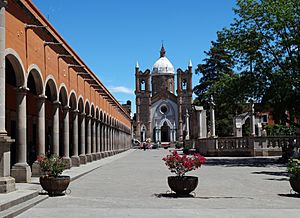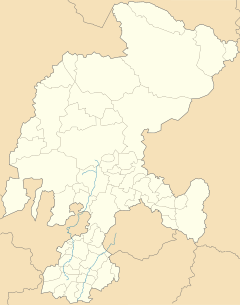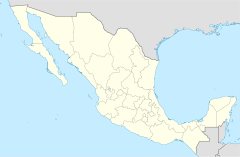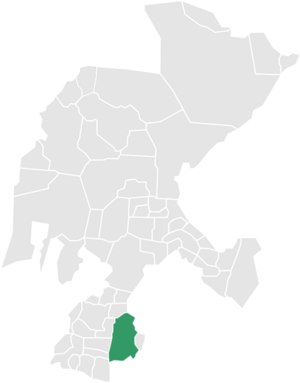Nochistlán facts for kids
Quick facts for kids
Nochistlán, Zacatecas
|
|
|---|---|
| Nochistlán de Mejía | |

Parián and Church of Nochistlán
|
|
| Country | Mexico |
| State | Zacatecas |
| Municipality | Nochistlán de Mejía |
| Government | |
| • Type | Ayuntamiento |
| Area | |
| • Total | 877.05 km2 (338.63 sq mi) |
| Population
(2010)
|
|
| • Total | 27,932 |
| • Density | 31.8/km2 (82/sq mi) |
| • Largest city | 16,562 |
| Time zone | UTC-6 (Central (US Central)) |
| • Summer (DST) | UTC-5 (Central) |
| Postal Code |
99900-99919
|
| Area code(s) | 346 |
Nochistlán is a city located in the state of Zacatecas, Mexico. It has a rich history, including being the first place where the city of Guadalajara was founded.
On December 3, 1531, a Spanish explorer named Nuño Beltrán de Guzmán asked Cristóbal de Oñate to create a new village in Nochistlán. This village was named Guadalajara to honor Guzmán. Guadalajara was officially founded here on January 5, 1532. Its first leaders included Cristóbal de Oñate. They worked on the town's first layout for about 16 months.
The first people known to live in this area were the Tecuexe, who settled around the year 1000. Later, in the 12th century, a new group called the Caxcan arrived. They came from a valley now located in Villanueva, Zacatecas. The Caxcan people took control of Nochistlán, forcing the Tecuexe to leave.
Contents
What is a Pueblo Mágico?
Nochistlán was given a special title: Pueblo Mágico, which means 'Magic Town'. This happened after its 481st anniversary. The Secretary of Tourism in Mexico, Gloria Guevara Manzo, gave it this name. Nochistlán was the fifth town in Zacatecas to become a 'Magic Town'.
To get this title, a town must have special qualities. These include unique traditions, interesting legends, a rich history, and important cultural events. It also needs to be a place that attracts many tourists.
Nochistlán: The Land of Musicians
Nochistlán is famous for its traditions and its love for music. It is often called la tierra de los músicos, meaning 'the land of musicians'. This nickname comes from the fact that music is always playing in the town.
The lively music of Nochistlán is one of the main reasons tourists visit. People also come to see the town's beautiful buildings and architecture.
How Does Nochistlán Make Money?
The economy of Nochistlán relies on three main activities. These are agriculture, which means farming. Another important activity is livestock, which involves raising animals like cows or sheep. Finally, trade is also a big part of the economy, where goods are bought and sold.
Getting Around in Nochistlán
Nochistlán is a rural area, meaning it's more like the countryside. Many people get around by walking because most places are close enough to reach on foot.
Cars, buses, and trucks are also used for transportation. Horses are still a common way to travel too. Special vans called "Combi vans" and motorcycles are very popular for getting around the town.
Many people in Nochistlán live close to nature. They use local resources, which makes the town feel a bit old-fashioned. However, in recent years, the town has been updating its way of life.
Nochistlán's Special Traditions
Nochistlán is known for its unique and lively traditions. These events bring the community together.
The Papaqui Festival
The oldest tradition in Nochistlán is called la fiesta del Papaqui. This translates to 'the party of el Papaqui'. It is celebrated every year from January 12 to January 20.
During this festival, the whole town honors St. Sebastian. He is a very important figure to the people of Nochistlán. For eight days, people in the plaza cover their faces with flour. They also crack colored eggs filled with confetti over others' heads. People even throw oranges!
These actions remember the past, when Native people and the Spanish were at war. The flour on faces symbolizes how people might have looked during those times. But the main goal of the fiesta is to celebrate St. Sebastian, the saint most admired in the town.
Sunday Serenades in El Jardín
Another famous tradition in Nochistlán happens every Sunday night. People gather in the main plaza, also known as el Jardín. This gathering is for la Serenata, which means 'the serenade'.
During the serenade, the men of the town form a circle around the plaza. The women walk inside this circle. In the past, if a man liked a woman, he would give her a Gardenia flower. Today, men often put confetti or hollowed-out eggs filled with confetti on a woman's hair instead.
There is also an inner circle for children and married women. They can also join in and have confetti thrown on them. This helps men know which women are married or in a relationship. The confetti and colors symbolize the beauty of the women. This tradition started to honor women and make them feel special.
The October Festivals
The Virgin of Toyahua is a respected figure in Nochistlán. Many people believe she can grant miracles. Residents often pray to her when they need help. Even though Nochistlán is a small town, it has a strong religious spirit.
The October festivals are religious parties that honor St. Francis of Assisi. They are celebrated on the second and third weekends of October. There is also a celebration on the first weekend of November.
During these parties, people gather in the plaza to enjoy music. Many bands and mariachi groups perform. Even though the festivals are religious, they are also big parties. Famous bands come to play, and the parties can last from 8:00 p.m. until 5:00 a.m.!
The women of the town come together to prepare food for everyone. The festivities also include traditional dances, exciting horse races, and rooster tournaments.
Sister Cities
Nochistlán has a special connection with another city. This is called being "twinned" or having a "sister city."
 Guadalajara, Mexico
Guadalajara, Mexico
Famous People from Nochistlán
Some well-known people have come from Nochistlán:
- Bernabé Meléndrez, an action film star
- Perro Aguayo, a professional wrestler
See also
 In Spanish: Nochistlán de Mejía para niños
In Spanish: Nochistlán de Mejía para niños




